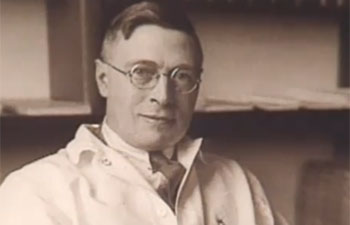A pioneer in insulin research
Professor Collip arrived at the University of Alberta (U of A) with his new PhD in 1915. Only 23, he was younger than many of his students.
During his 13 years at the U of A, he published 77 papers, including one on the discovery of the parathyroid hormone in 1924. He received a DSc from the U of A in 1925 and earned his MD the next year. He became a member of the Royal Society of Canada in 1925 and the Royal Society of England in 1933.
When two of the five faculty of medicine staff went overseas, he took over a colleague’s pharmacology teaching load in addition to his own to sustain the faculty during the First World War.
VIDEO: Canadian Medical Hall of Fame video about the work of Dr. James Collip.
In 1921, he received a Rockefeller Travelling Fellowship that started at the McLeod Laboratory at the U of T (which specialized in measuring blood glucose levels).
Two weeks after he started, he concentrated a pancreatic extract, induced hypoglycemia in a rabbit and then reversed it with glucose. The next month (in January 1922), his extract (named insulin) was successfully administered to the first patient He later received one-sixth of the royalties for his own research. When the Banting team received the Nobel Prize in January 1923, Professor McLeod shared his half of the $24,000 award with Dr. Collip.
In a 1923 course with Dr. Jamieson on insulin, Dr. Collip convinced a student in the audience, Dr. John Scott, to join him and eventually replace him on the U of A faculty.
Dr. Collip became the dean of medicine at the U of A in 1948. His many other achievements included:
- 249 publications.
- 12 honorary LLDs.
- Membership on the insulin team that received the first Frederic Newton Gisborne Starr Award from the Canadian Medical Association in 1935.
- The Banting Medal in 1960.
Dr. Collip followed Dr. Banting as the Medical Research Council of Canada Chairman in 1943.
